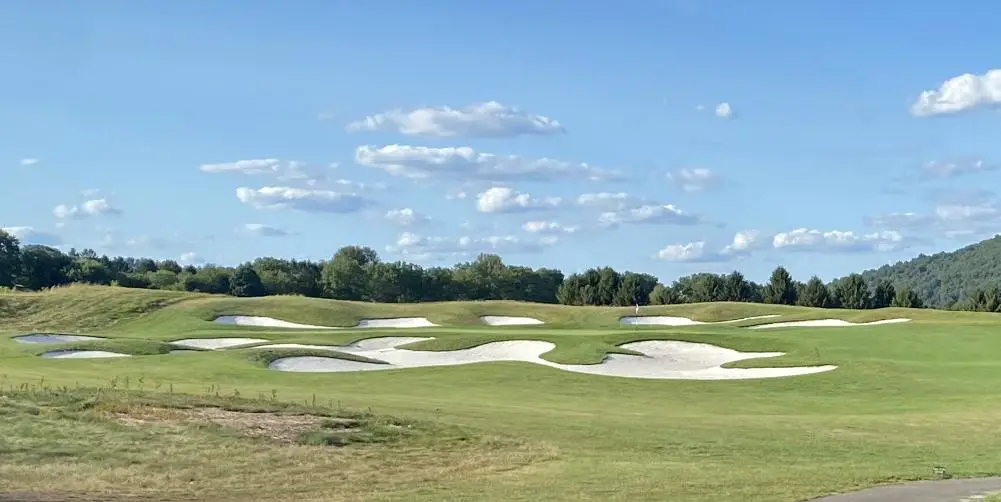Golf is a tough game, but some courses can make a round seem almost unbearable. Blind tee shots, guarded greens, and tight fairways are all hallmarks of a difficult course.
None of these features alone will make a course unplayable so what is it that makes a golf course truly difficult?
We all know a tough course when we are playing it, but it can be difficult to describe what makes a course difficult to play. Each course has its own unique composition that affect the way the course is played.
The combination of course design, green difficulty, climate, terrain, hazards, and course maintenance all play into how grueling a course can play.
If all of these factors are optimized to be challenging, course can play unbelievable hard. In the article below, we are going to do a deep dive into all these factors to discover what truly makes a golf course difficult to play.
1.) Greens
Bobby Locke famously said that “You drive for show but putt for dough.” Putting is fundamental to scoring well, but for many, it is the most difficult aspect of the game. The hardest courses boast lightning quick greens on undulating slopes which make the most seasoned golfer uncomfortable.
The hardest courses will constantly challenge their patrons via their pin placements and green speed and slope. Navigating these challenging greens is the hallmark of a great golfer.
2.) Course Design
The toughest and most beautifully designed courses are integrated into their surroundings. A course intertwined with its climate and terrain becomes one of the local topography and seamlessly fits in with the local environment.
The most famous golf architects are able to incorporate the local climate, terrain, hazards, and proper golf course maintenance to create beautiful, yet demanding, golf courses.
For example, Donald Ross was famous for difficult greens and deceiving hazard placement. Ross had the ability to make the seemingly simple golf hole challenging yet scorable.
Golf architects all have their own unique hallmarks of design that impact the difficulty of playing the course.
3.) Climate
Weather is a critical factor to consider when determining the difficulty of a course. The most benign golf course can become excruciatingly difficult during extreme weather. Courses built in climates that are prone to quick and harsh weather changes can be some of the most difficult courses in the world.
Look no further than classic links golf to see the impact of extreme weather on course difficulty. St. Andrews, Pebble Beach, Whistling Straits, the list goes on for these most iconic challenging link style courses.
Links style courses are traditionally built on the coast, leaving each shot open to the mercy of incoming weather. Wind gusts can reach well north of 30 mph and can change in direction and speed at any moment.
4.) Terrain
A golf courses’ terrain is intertwined with its design. Undulating hills in mountainous regions, marsh lands near the ocean, or natural sand in the desert are all incorporated into the layout of the course.
The landscape of a course dramatically impacts the feel and difficulty of the course. In harsher terrains, you will naturally see the difficulty of the course increase.
Another culprit that can increase the difficulty of a golf course is hazards. Tactically placed bunkers, high fescue, overhanging trees, and water all can make a seemingly benign hole and make it extremely difficult.
5.) Hazards
The best golf architects are able to use hazards as a risk reward object on the course. Tempting you to drive it over the fairway bunker rather than laying up or taking aim at the pin directly over water instead of laying up on the safe part of the green. Hazards are an important component of the game of golf, and when used properly, they add an extra element of difficulty to the course.
6.) Course Maintenance
Once a course is designed, the long hard work of maintaining and upkeeping the course starts. Maintenance is key to keeping a golf course playing difficult.
Lighting fast greens and thick fescue are all at the mercy of the grounds crew keeping the course in tip top shape. Courses maintained at a high level can play much more difficult than golf courses with low standards for care.
Are Golf Courses Rated For Difficulty? (Course Rating vs Slope)
The USGA uses Course rating, Bogey rating, and Slope rating to evaluate the playing difficulty of a course. These ratings take in multiple factors from the course including course length, topography, hazards, layout, to name a few.
Course rating is used as the estimated score for a scratch player whereas the Bogey rating represents the projected score for a bogey player. The difference between the Bogey rating and Course Rating and the is used in the determination of the Slope Rating.
For a complete list and outline of the rating factors, check out the USGA website for a detailed overview.
What Is The Average Course Difficulty?
Now that we know how golf courses are rated for difficulty, what is the average slope for a golf course. A Slope Rating of 113 is considered the standard relative difficulty for the average golf course.
Final Thoughts
The difficulty of a course is determined by multiple factors. Golf course architects have the ability to use a variety of obstacles and elements to toughen the course design.
Check out the course website before playing to understand how difficult the course is to play. Use the course rating and slope rating to know what to expect from the course before teeing up!
Hopefully you liked this article and found it informative. Check out our other blog posts if you liked this one!



1 thought on “6 Factors That Make a Golf Course Difficult”